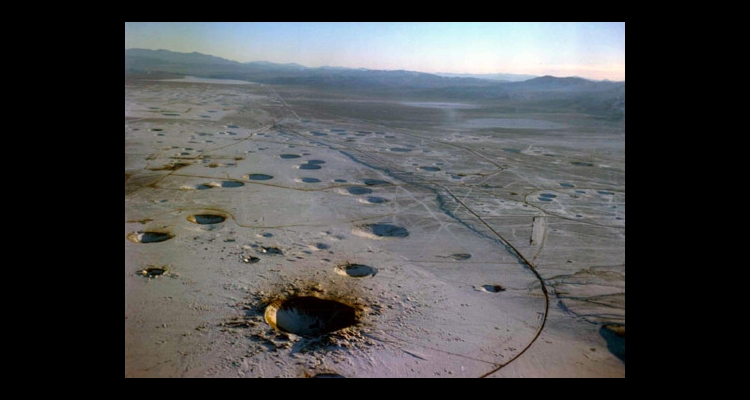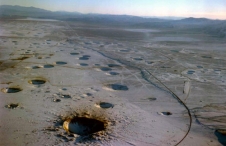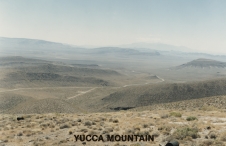Atmospheric Nuclear Testing at the Nevada Test Site
One hundred atmospheric nuclear tests were detonated at the Nevada Test Site (originally the Nevada Proving Grounds) between 1951 and 1963. The first Nevada series, code-named Ranger, was conducted during January and February 1951, immediately after President Harry S. Truman had approved the establishment of a continental test site in Nevada. The United States’ first post-World War II nuclear tests had been conducted in the Pacific. During the early years, testing schedules remained on a campaign basis, alternating between the Nevada Test Site (NTS) and the Pacific Proving Ground. Generally, larger tests were conducted in the Pacific—the highest-yield U.S. test was Bravo with fifteen megatons, detonated at Bikini Atoll, while the highest-yield test at the NTS was Hood, at seventy-four kilotons.
In the early days of testing, there was an urgent need to understand the science and engineering of these powerful new weapons, their use on the battlefield, and their effects. Tests were conducted for a variety of reasons—to test and prove new designs, to assess the effects of nuclear weapons, to develop warheads for specific delivery systems. Meteorologists monitored weather patterns, pilots flew airplanes through the radioactive clouds to sample radiation levels, and scientists “chased” fallout clouds across the Nevada desert to better understand offsite impacts. Nuclear device designs were developed by scientists at the U.S. nuclear weapons laboratories. Los Alamos was the first, having been established during World War II to develop the first atomic bomb. The University of California Radiation Laboratory (later Lawrence Livermore National Laboratory), began testing weapon designs at the NTS in 1953.
Ranger, the first test series at the NTS, was conducted in early 1951 with nuclear devices designed by Los Alamos scientists and airdropped from bombers out of Kirtland Air Force Base in Albuquerque, New Mexico. The next NTS series, Buster-Jangle, was a joint Los Alamos-Department of Defense (DoD) operation conducted during October-November 1951. The series tested both new weapons configurations and weapons effects. The DoD tests were designed to better understand the cratering capabilites of nuclear weapons for the battlefield. The test code-named Sugar was the only test ever detonated at the surface, on the ground in Nevada—as opposed to an airdrop, tower, or balloon shot. It created a crater twenty-one feet deep and ninety feet wide. Buster-Jangle also involved the first troops from the U.S. Army’s Atomic Maneuver Battalion, stationed at Camp Desert Rock outside the test site town of Mercury. Between 1951 and 1955 thousands of military personnel from all service branches served at Desert Rock, participating in maneuvers at the test site, witnessing atomic blasts from trenches, marching toward ground zero after detonations and collecting radiation effects information.
The 1953 test series, Upshot-Knothole, was significant for its above-ground testing and its impacts on citizens in surrounding communities. This series was also the first time that the Livermore laboratory fielded tests at the Nevada Test Site. The first test of the operation, code-named Annie, was a Los Alamos device and was also the first conducted with the Federal Civil Defense Administration (FCDA). Two typical American houses were built at 3,500 and 7,500 feet from the Yucca Flat ground zero where a sixteen-kiloton device was detonated from a 300-foot tower. The houses were stocked with food, furnished, and populated by clothed mannequins. Automobiles donated by leading U.S. manufacturers were placed in the path of the blast. The simulation of an atomic attack also tested underground shelters containing mannequins at varying distances from the blast. For the first time, an atomic test was televised, with civil defense personnel and the media witnessing it from an area dubbed News Nob.
For the Encore test of May 8, 1953, 145 ponderosa pines were brought from Kyle Canyon to the NTS and placed in concrete bases. They were subjected to the blast as an experiment to determine the effects of an atomic attack on a forest. The May 19, 1953 test, code-named Harry, used an important new weapon design. Later dubbed “Dirty Harry” by communities downwind of the test site in Nevada and Utah, it produced the highest level of off-site contamination of any continental U.S. test.
For the Upshot-Knothole Grable test, the military was trying to determine the feasibility of an atomic cannon for the battlefield. In preparation for the test, two 280 mm cannons were brought to the NTS from Fort Sill, Oklahoma, along with artillery crews. After many practice rounds, on May 25, 1953, an atomic shell was fired from a cannon at Frenchman Flat, detonating at 524 feet with a yield of fifteen kilotons. This was the first and last use of a nuclear artillery shell. It was determined that the cannon and shell would be too heavy to maneuver on the battlefield. The cannon, nicknamed “Atomic Annie,” is at Fort Sill.
It is estimated that the Upshot-Knothole tests as a whole could have been responsible for nearly one-quarter of all radiation exposure due to the continental testing program. Many illnesses are believed to have been the results of fallout; lawsuits and federal government compensation programs have resulted from the years of atmospheric testing at the NTS. Ranchers reported impacts to their livestock and some milk supplies were compromised. Many families and communities in the Intermountain West, along with test site workers and military veterans, report living the legacy of this era through ongoing pain, suffering, and loss.
On May 5, 1955, another FCDA test, code-named Apple-2, was conducted, involving much more elaborate civil effects experiments than the 1953 Annie shot. The twenty-nine kiloton device was placed at the top of a 500-foot tower in Yucca Flat. More houses were built, using different materials and exteriors at differing distances from ground zero. Tours of the Nevada Test Site allow the public to see the remains of weapons effects tests conducted during the 1950s. These relics include the remnants of the Apple-2 tower at ground zero, houses, shelters, steel frames, a bank vault, and other structures.
Experiments on mice, dogs, and other animals were conducted during atmospheric testing. The animals were subjected to the atomic blasts and then analyzed by biologists, veterinarians, and medical personnel. In 1957, for the Plumbbob series, pens were built near the Mercury highway to keep 1,200 swine that would be used for various experiments. They had been specially bred due to the similarities in pig and human physiology. For some experiments, pigs were outfitted in various types of clothing material, including military uniforms. For the thirty-seven-kiloton Priscilla test on June 24, 1957, more than seven hundred anesthetized pigs were placed in stations at various distances from ground zero to better understand the effects of atomic weapons on human beings. On July 5, 1957, Hood, the largest atmospheric test at the NTS, was conducted with a yield of seventy-four kilotons. The August 31, 1957, Smoky event yielded forty-four kilotons, after which thousands of military troops conducted post-shot exercises. In the 1970s, congressional inquiries and medical studies were conducted into the effects of exposure of service personnel during the Smoky test due to incidents of cancer among the troops.
In the fall of 1958, the largest series to date was conducted at the NTS, code-named Hardtack II, consisting of thirty-seven tests within a two-month period. The reason for the great number of tests within a short time was that President Dwight D. Eisenhower had declared that on October 31, the United States would enter into a unilateral nuclear testing moratorium. The Soviet Union followed suit.
However, in September 1961 the Soviet Union resumed its testing program, including a fifty-eight-megaton test, the largest nuclear device ever detonated. The United States returned to testing at the NTS, in the Pacific, and in other locations. The NTS tests were primarily underground with most atmospheric tests in the Pacific. The Sedan test of July 6, 1962, was a large-scale excavation experiment for the Plowshare program, investigating peaceful uses of nuclear detonations for the creation of harbors, channels, dams, etc. The device was buried and detonated 635 feet beneath the desert floor. With a yield of 104 kilotons, Sedan exploded into the air and created a crater 1,280 feet wide and 320 feet deep. The general public can view the Sedan crater during tours of the NTS.
In spite of the return to testing, during the next few years progress was made on a treaty prohibiting certain kinds of nuclear tests. On July 17, 1962, a low-yield, joint Sandia National Laboratories/Department of Defense experiment code-named Little Feller I was the final atmospheric test conducted at the NTS. The United States continued to test in the atmosphere in other locations, primarily the Pacific. On August 5, 1963, the U.S. and the Soviet Union signed the Limited Test Ban Treaty (LTBT), banning nuclear tests in the atmosphere, as well as in the ocean and in space. The era of above-ground nuclear testing in Nevada had ended.








